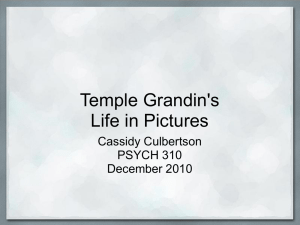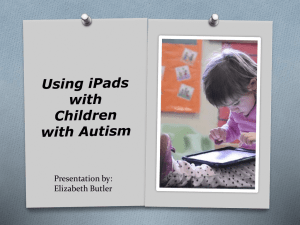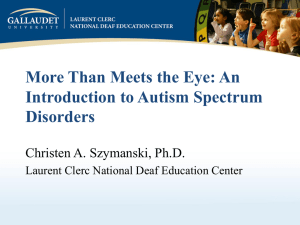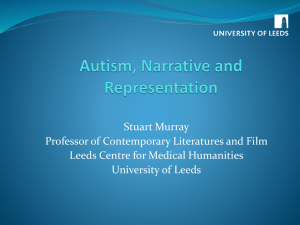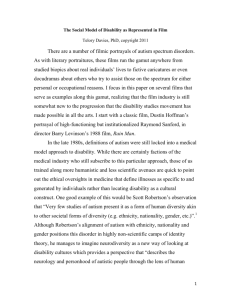Thinking in pictures: My life with autism Dr. Temple Grandin
advertisement
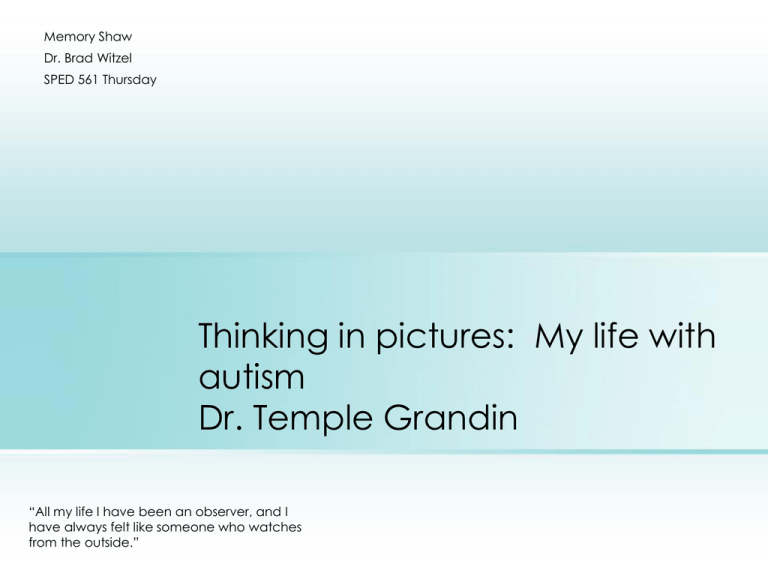
Memory Shaw Dr. Brad Witzel SPED 561 Thursday Thinking in pictures: My life with autism Dr. Temple Grandin “All my life I have been an observer, and I have always felt like someone who watches from the outside.” SUMMARY • Thinking in Pictures is the story of Dr. Temple Grandin’s life as she struggled to succeed in the world as a person with Autism Spectrum Disorder. • Her story touches on issues she faced from early school experiences, dating, religion, college life and her career. • Dr. Grandin provides the reader with firsthand knowledge into the world of an autistic brain; offering many explanations for behaviors and help in understanding for anyone who experiences autism in their life. Reflection one: Visual Perception • • • • People with Autism relate to the world by creating visual images in their minds. When they recall words or events it must relate to a visual picture for them to make connections. For example, to remember a person’s name, one would have to recall a visual image of the person’s face and make the connection. Visual pictures must also exist for vocabulary and objects. EX: A 14 year old student calls a chair “sit down” because she relates the function to the words she has always heard. Eye contact is very difficult for people with autism. Dr. Grandin quotes: “autistic people with normal vision have depth perception problems and problems processing visual information in the brain. Looking into other people’s eyes is difficult because their eyes do not stay still” (Grandin, 1995, 69). Reflection 2: Sensory Deficits •Many people with autism have difficulties with all their senses. They will be tactile sensitive, very picky eaters, and highly oversensitive to smells and sounds. •Smell is a more reliable sense than vision or hearing. •Many can not tolerate the smell, texture, taste or sound of food in their mouth. •Many persons with autism say that they cannot interpret 2 senses at one time. Ex: They cannot hear and see at the same time. •Many people with autism report boundary issues within their bodies. Some claim that the rocking motion commonly associated with autism is due to a failure to feel their own bodies unless it is in constant motion. . -Grandin, 1995, Chapter 3. Reflection 3: No Limit To Success • Dr. Grandin graduated high school, junior college and earned a doctorate degree. • Over 1/3 of the cattle and hog handling facilities in the US operate on designs by Dr. Grandin (Grandin, 1995, 167). • Autistic savants can accomplish amazing feats of memory, drawing calculations, even musical composition…and yet have no social skills (Grandin, 1995, 216). • There is, however, no limit to what a person with autism can achieve with proper education and mentoring. • Often times, people with autism can function when taught appropriate social responses and behavior with a model. This often includes how to dress, how to have a conversation, even how to express emotions properly. Application for Educators • • • • • • • • Common autistic characteristics are engagement in repetitive activities, resistance to change, unusual responses to environment or sensory experiences and stereotypical movements (Lerner, 2006). Educators for individuals with autism must always focus on routine, schedules, visual imagery, concrete ideas and sensory integration. Teachers should use pictures to aid in communication. Be conscious of clothing you were: avoid clothes with varied patterns or designs. Leave off the perfume/cologne – oversensitivity to the smell could be painful to the child with autism. Also applies to sounds; often noises barely audible to us are amplified in the autistic mind. Praise and positive reinforcement are your most valuable tools. Rewards are motivators. Remember to allow for personal space. Many people with autism cannot tolerate touch. Teach knowing that all students CAN learn. References Grandin, Temple. 1995. Thinking in pictures: My life with autism. Vintage Books, New York. Lerner, Janet. 2006. Learning disabilities and related disorders: Characteristics and teaching strategies. Houghton Mifflin Company, Boston, Massachusetts. Other Books By Temle Grandin, Ph.D. • Emergence: Labeled Autistic • Livestock Handling and Transport • Genetics and the Behavior of Domestic Animals • Developing Talents • Animals in Translation
